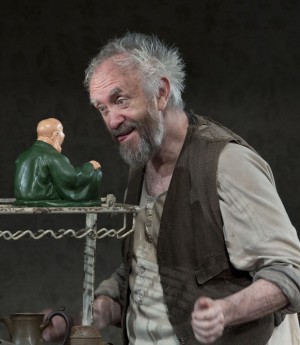‘The Caretaker’: Electrifying Performances in a Dull, Dark World
A tramp has wandered onto the stage of BAM’s Harvey Theater. His tattered shoes fit poorly, tufts of his hair stick up, and you can practically smell the stink rising off of his unwashed body. He’s the type of man who you might slink past to the other end of a subway car to avoid. And in this production of Harold Pinter’s seminal play The Caretaker, two-time Tony Award-winning actor Jonathan Pryce deftly embodies him in a performance that ping-pongs back and forth between humorous and harrowing.
Pinter wrote The Caretaker in 1960 and, almost immediately, it marked him as an emerging talent with whom to be reckoned. Works of his like The Homecoming and Betrayal currently hold their own as contenders for top modern drama, but The Caretaker has proved enduring. The germ for BAM’s production began over two years ago, when it played in London to ecstatic reviews. Now, with director Christopher Morahan and lead actor Pryce intact, it has hopped across the pond to both entertain and horrify American audiences with its insights into human cruelty and hopelessness.
In The Caretaker, power dynamics go haywire within a trio of men. At the play’s start, one of these men, the professionally dressed, seemingly benevolent Aston (Alan Cox) has rather mysteriously taken in the aforementioned tramp, Davies, rescuing him from a bar fight and spiriting him away to the junk-filled apartment where he resides. Soon, Aston’s abrasive brother Mick (Alex Hassell) shows up and, in this cluttered room, the three men form and break alliances, taunt one another mercilessly, and talk of dreams deferred. For each man has a dream, or at least something to which he clings. Davies talks constantly about nearly everything, but keeps returning to an assertion that he will soon travel to the town of Sidcup, where he claims he can obtain the papers that will legitimize him. Mick, who, despite his rough appearance, actually owns the apartment building where his brother stays, has set his sights on remodeling the living quarters until they’re fit for a king. And Aston just wants to build a shed in the back garden. As the play progresses, you slowly come to realize that none of these dreams will ever come true, no matter how easily they might be attained. The characters cannot find it in themselves to take the necessary action, distracted by the smaller matters at hand and preferring to soothe themselves with anodyne fantasies.
The acting at every vertex of the triangle is top-notch. Pryce will no doubt garner well-deserved attention for his total submergence into the manipulative Davies. His fingers flutter in the air at the side of his head when he’s agitated, and he speaks circuitous sentences with a rough accent. In moments, he can be utterly charming. At other times, he reeks of desperation and calculation. When Aston gives him a key to the apartment, Pryce as Davies becomes a man touched by the trust invested in him. But as soon as the door closes and he’s alone, he tears through the room, looking for valuables with a mad glee. Somewhat incredibly, Hassell and Cox manage to hold their own. Hassell gives off a magnetic aura that tilts toward the dangerous, while Cox reveals more of what motivates Aston, and, in the process, he breaks your heart. One of the play’s strongest moments comes in the extended monologue when Aston explains to Davies how he got to his current situation. A spotlight hits him as he sits on his bed. The other lights onstage, effectively designed by Colin Grenfell, slowly fade until Cox rests in a prison of brightness, illuminated and isolated by his out-of-control thoughts.
The other compelling moment in the play dispenses with the cerebral and celebrates the physical in a Beckett-like bit of comedy. Alton returns to the apartment with a bag of clothes for Davies, who has just encountered the mysterious Mick for the first time. As Alton hands the bag to Davies, Mick grabs it away, and the three of them begin an elaborate sequence of snatching and passing. The ingenuity on display as these three grown men struggle for a bag startles with its hilarity, even as the stakes of who will end up with the object feel impossibly high. The choreography of the bag sequence is every bit as enjoyable as a Broadway dance number. Plus, the levity involved provides a welcome respite from the soul-crushing and spite that tend to permeate the rest of Pinter’s script.
The production’s other aspects keep pace with the acting. Most notably, Eileen Diss has designed a set that captures the desperation and squalor in which these characters live. A bucket hangs from the ceiling to catch drips of rainwater coming in the roof, piles of paper litter the floor, and a statue of Buddha sits among other useless knick-knacks on the shelves. Occasionally, the walls turn translucent so you can see events happening in the hallway outside the room. Costumes by Dany Everett handily evoke the class disparities between characters, while the sound design by Tom Lishman plunges you into the noises of the neighborhood.
Ultimately, watching two and a half hours of humans being cruel to one another doesn’t necessarily qualify as an enjoyable experience. In fact, Pinter’s view of the world can be a depressing one. But in The Caretaker, you can leave heartened by the knowledge that, alongside all the treachery and loneliness you may encounter in life, at least the opportunity to see some fantastic acting exists along the way.
“The Caretaker” can be seen through June 17th at The Bam Harvey Theater at 651 Fulton Street, Brooklyn, New York, 11217. For more information visit: www.bam.org or call 718-636-4100.


